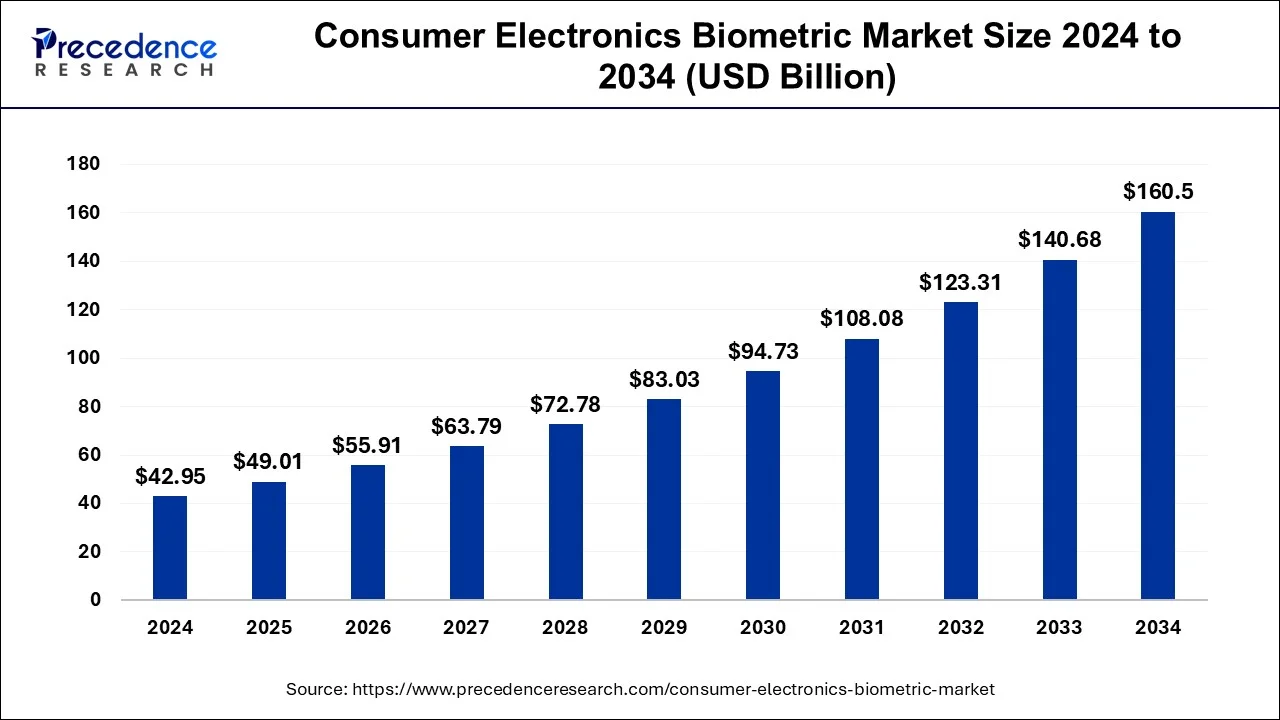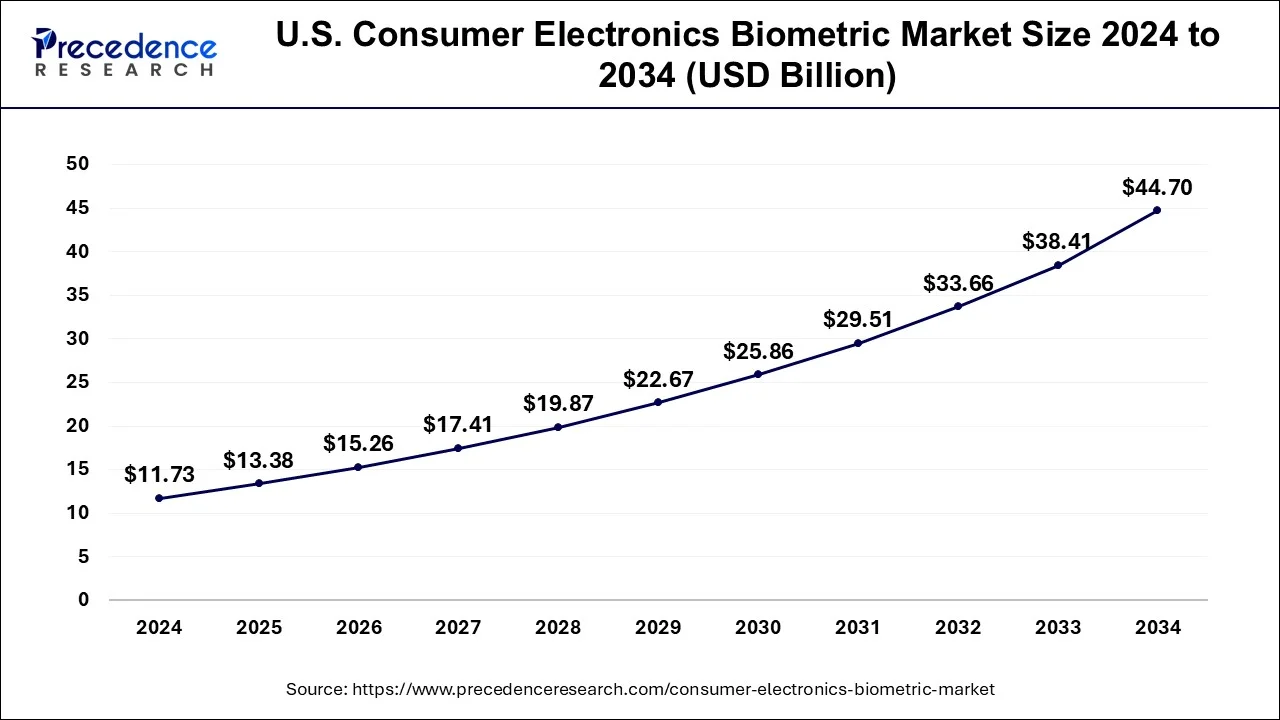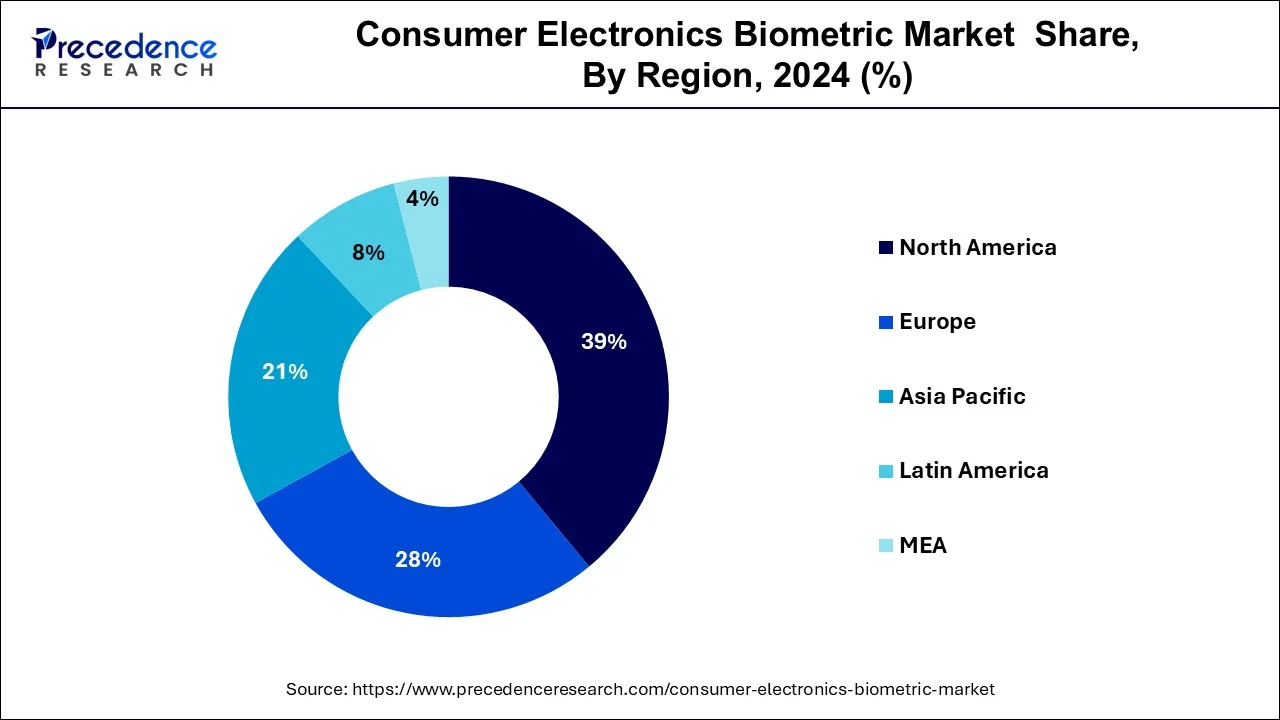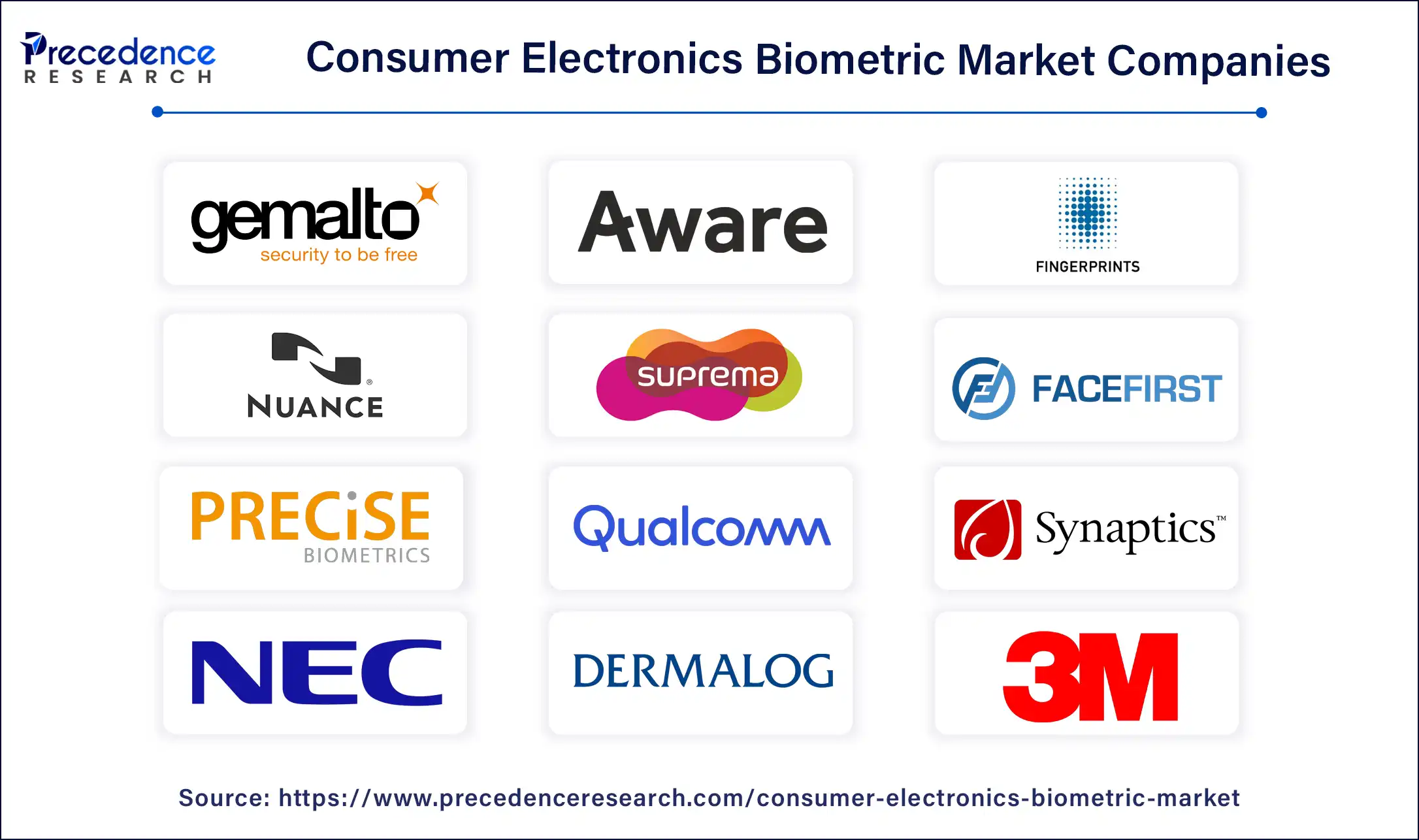October 2023
The global consumer electronics biometric market size is evaluated at USD 49.01 billion in 2025 and is forecasted to hit around USD 160.50 billion by 2034, growing at a healthy CAGR of 14.09% from 2025 to 2034. The North America market size was accounted at USD 16.75 billion in 2024 and is expanding at a CAGR of 14.24% during the forecast period. The market sizing and forecasts are revenue-based (USD Million/Billion), with 2024 as the base year.
The global consumer electronics biometric market size was calculated at USD 42.95 billion in 2024 and is predicted to reach around USD 160.50 billion by 2034, expanding at a CAGR of 14.09% from 2025 to 2034. The rising cyber fraud and data infringement due to lack of security purposes is driving the growth of the market.

Artificial intelligence significantly impacts the expansion of the consumer electronics biometric market by integrating the latest features and technologies. AI is used in different types of biometrics, such as in facial recognition systems; it helps in the false acceptance ratio. In fingerprint recognition, the problems in detecting fingerprint identification are solved, such as damaged fingerprints, skin conditions, and others. There are several benefits associated with the implementation of AI into biometrics, which help enhance its performance and accuracy level.
The U.S. consumer electronics biometric market size was exhibited at USD 11.73 billion in 2024 and is projected to be worth around USD 44.70 billion by 2034, growing at a CAGR of 14.31% from 2025 to 2034.

North America dominated the consumer electronics biometric market in 2024. The growth of the market is attributed to the rising industrialization and the adoption of advanced gadgets and technologies by people, which is driving the integration of biometric authentication technology for identification and security purposes. The increasing economic development in regional countries like the United States and Canada, with the higher number of disposable incomes in the population, is inclining them towards consumer electronics and technology gadgets, and the rising presence of the technology leaders.

Europe expects significant growth in the consumer electronics biometric market during the forecast period. The increasing demand for the technology’s gadgets is accelerating the growth of the market across the region. The increasing development in industrialization, such as healthcare, automotive, banking, automotive, and others, are driving the demand for biometrics authentication.
The biometrics are one of the leading authentication technologies designed for identification individuals in more faster and convenient manner. The technology is used to capture the biometric data from the individual with recognizing their fingerprint, facial detection, or fingerprint. The individual’s data is compared with the other biometric data of other persons, which is kept in the database. The increasing adoption of biometrics from different industries is driving the growth of the market.
| Report Coverage | Details |
| Market Size by 2024 | USD 42.95 Billion |
| Market Size in 2025 | USD 49.01 Billion |
| Market Size in 2034 | USD 160.50 Billion |
| Market Growth Rate from 2025 to 2034 | CAGR of 14.09% |
| Leading Region | Asia Pacific |
| Fastest Growing Region | Europe |
| Base Year | 2024 |
| Forecast Period | 2025 to 2034 |
| Segments Covered | Technology, Application, End Market, Security Level, and Regions |
| Regions Covered | North America, Europe, Asia-Pacific, Latin America, and Middle East & Africa |
Adoption of biometrics from businesses
The increasing adoption of biometrics by leading businesses owing to its benefits is driving the growth of the consumer electronics biometric market. Biometrics provides several advantages to the business, including protecting the consumers and businesses from financial loss, helping in personalizing the consumer experience as per the customer demand, reducing the cost of operations, ensuring the regularity requirements, and others.
Privacy concern
The data privacy issues associated with biometrics data collection and storage, the lack of reliability and accuracy, and data security risk due to biometrics not being hack-proof, though there is a chance of data leakage or data hacking, are some of the leading limitations in the consumer electronics biometric market. Additionally, the lack of standardization, legal and ethical issues, accessibility issues, high implementation costs, and others are collectively restraining the growth of the consumer electronic biometrics market.
Increasing demand from banking institutions
The integration of the consumer electronics biometric market into banking and financial institutions is revolutionizing the banking experience. It is used in the different applications of banking, such as KYC (customer onboarding), ongoing customer authentication, secure ATM transactions, and employee authentication, and provides benefits such as increasing security, streamlining operations, reducing fraud, and ensuring customer safety. Furthermore, the integration of biometrics into banking enhances the user experience, prevents the risk of fraud, allows convenience to use, helps with regularity compliance, offers faster, secure, and friendly authentication, enhances the security for contactless payment, and others.
The fingerprint recognition segment led the consumer electronics biometric market in 2024. There are significant advancements in technology and the rising adoption of fingerprint technology from a wide range of industries such as banking and financial services, laws and judiciary, and others for security enhancements. The fingerprint technology uses unique patterns to verify and authenticate the identities in various applications. It provides unmatchable accuracy for identity verification. It simplifies the complex tasks of verification and identification and reduces the need to remember passwords and physical tokens.
The iris recognition segment will witness significant growth in the consumer electronics biometric market during the forecast period. The Iris technology is the type of biometrics authentication that uses the irises to uniquely identify. The Iris technology depends upon the high-resolution picture of the iris captured by the specialized scanners and cameras for identifying features like the arrangement of crypts, furrows, and rings. The technology provides high-quality security services to various industries, such as banking and financial services, airports, offices, and others.
The single-factor authentication segment held the largest share of the consumer electronics biometric market in 2024. The single-factor authentication is the technology that provides the verifiable credential to access online resources. Password-based authentication is one type of single-factor authentication. The increasing adoption of single-factor authentication by different devices or websites is driving the growth of the market.
The multi-factor authentication segment will witness significant growth in the consumer electronics biometric market during the forecast period. In this type of authentication, users need to provide more than one password or verification details. This type of authentication is designed to enhance the security system for sensitive information.
The smartphone segment dominated the consumer electronics biometric market in 2024. The increasing penetration of smartphones by the population due to the rising demand for efficient telecommunication devices with additional features is driving the consumer base for smartphones. The rising advancements in smartphone technology and the integration of biometric authentication technology such as fingerprint sensors, iris scanners, and facial recognition for the security of the different applications in smartphone devices.
The wearables segment is anticipated to show notable growth in the consumer electronics biometric market during the anticipated period. The increasing demand for wearable gadgets by the population, such as the evaluation of the smartwatch and fitness tracker with the integration of biometrics authentications for the security and authentication of identity, is driving the growth of the market in the wearable application segment.
The consumer segment dominated the global consumer electronics biometric market in 2024. The increasing consumer base for technologies such as smartphones, tablets, laptops, wearable gadgets, and other technologically advanced gadgets with integrated biometrics authentication technology to restrict security infringement and prevent gadget theft is driving the market's growth.
The business segment will experience substantial growth in the consumer electronics biometric market during the predicted period. The increasing industrial and commercial infrastructure across the world causes a higher demand for biometrics authentication systems for attendance, security purposes, and convenience purposes. The increasing adoption of biometrics authentication from different industries, such as government, healthcare, and education.

By Technology
By Application
By End Market
By Security Level
By Geography
For inquiries regarding discounts, bulk purchases, or customization requests, please contact us at sales@precedenceresearch.com
No cookie-cutter, only authentic analysis – take the 1st step to become a Precedence Research client
October 2023
April 2025
January 2025
January 2025